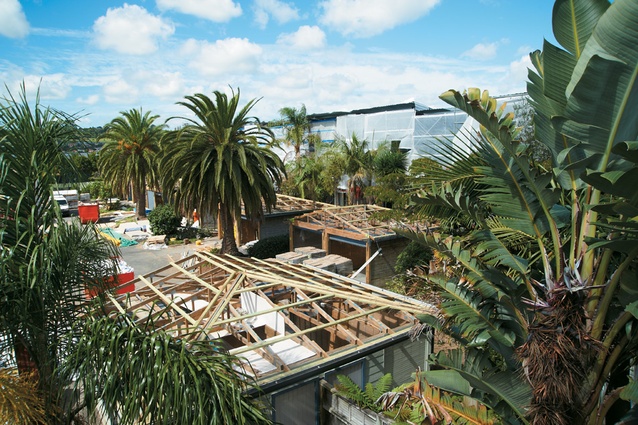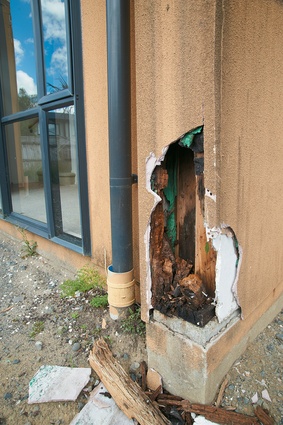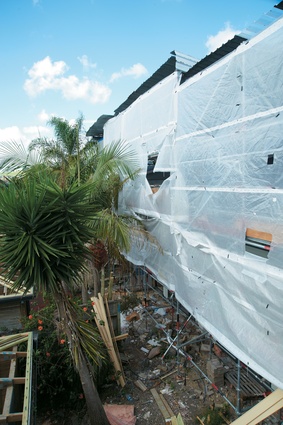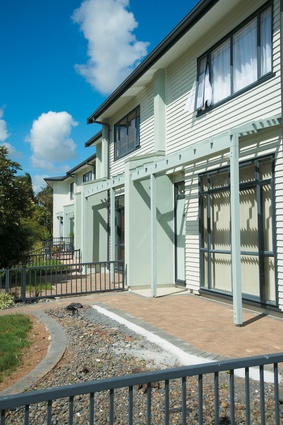Restoring value to Sacramento Apartments
New Zealand's largest leaky building remediation project - the Sacramento Apartments complex in Auckland's Botany Downs - was completed in August this year, on time and under budget.
The Sacramento Apartments complex, a seemingly idyllic development of Mediterranean style condominium units in Auckland’s Botany Downs with palm trees lining its landscaped roads and paths, was built in 2000.
But the trendy façade was hiding a dark secret. Severe leak problems soon emerged and in 2003 the development hit the headlines as one of the first and the largest instances of owners seeking compensation for their plight through the High Court. With wide coverage on television and in print media, it was also one of the most high profile leaky building cases in the country.
In terms of the number of owners involved, the 153-unit complex is – so far at least – the largest leaky building remediation project undertaken in New Zealand.
Homeowners were awarded $11m in 2008 from some companies involved in the design and construction. This was after the Court of Appeal ruled the owners were not entitled to pursue claims against local or central government agencies in regards to compensation. The Sacramento body corporate’s secretary Craig Leishman, director of Boutique Body Corporate, was engaged by the owners to help guide them through the remedial work.
“My involvement in the Sacramento project started in a cold and draughty hockey clubrooms with 14 of the property’s owners,” recalls Leishman. “The owners had the money in the bank from the settlement but were unsure about how to proceed. They had received a number of proposals from consultants but were going around in circles.”
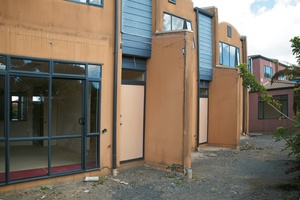
Leishman’s team started by putting in place a legal structure and developing a formula on how the funds would be distributed. After working through the options and cost differentials it was decided that recladding was the best approach. The goal was to restore financial value in the 153 units for the owners. CoveKinloch was appointed to design and project manage the remediation works and after a tendering process, Canam Construction won the $18 million contract to repair and reclad the entire development.
“We were a little nervous at first, as this was Canam’s first major leaky building project,” says Leishman. “We took a bit of a risk but in the end they did a tremendous job and finished the job on time and under budget.” The Sacramento complex was built with features that are now defined as the classic leaky building look: tiled roofs with no eaves, flat fibre-cement clad and plastered façades, with no drainage cavities and untreated timber framing.
Martyn Cleary, senior project manager for CoveKinloch, says the scope of the remedial work has included removing roof and wall claddings, decks and windows, while making sure fire and structural issues were complied with.
“New cavity cladding systems including painted timber and fibre cement weatherboard and STO exterior plaster cladding have been installed,” says Cleary. “Roof lines have been modified to allow for soffits to replace the original parapets, which were found to be defective.” New long-run corrugated steel roofs were installed on all units along with new decks, balustrades and tiling, and 70,000 concrete tiles from the apartment roofs were salvaged and sold to a roofing company for reuse instead of being sent to landfill. In addition, structural steel and concrete stair access ways have replaced the decayed timber stairs.
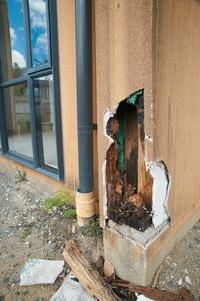
Canam Construction director Nick Page says that working on the project was not like simply working on one project, because each of the 153 units presented its own unique challenges. “It depended on the weather exposure and the quality of the application of the cladding,” says Page. “The complex was originally built by a number of different builders so we uncovered significant variability in the quality of the original workmanship and that had some effect on the problem as well.
“But fundamentally, the design and the materials were classic leaky building. The detailing now addresses those issues that have been identified as contributing significantly to leaky building syndrome.”
With new eaves added, purpose-made flashing kits installed around windows and doors, adequate ground clearances provided for and a drained and ventilated cavity provided to the external walls, Page says unit owners can now have confidence in the durability of their home or investment property.
“Everything you see now is actually designed to take the water away from the building with the bigger eaves and flashings; it’s designed to keep water away from any place it can get in,” says Brent Papworth, site manager for Canam Construction.
With a project this size, and given the high stakes involved in regards to owner occupiers, one of the biggest challenges was coordinating the contractors and liaising with the owners and tenants. “It was a huge challenge, so we decided to engage the services of a clerk of works. It was one of the best investments the body corporate made and made a big difference to the project,” says Leishman. The clerk of works was Kevin Ahern, who had worked with Craig before.
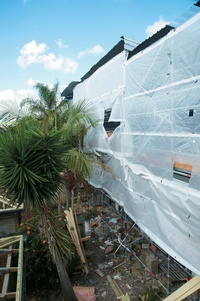
With three or four site blocks in progress at any one time and nine stages in total it was a big, complex job. A large part of Kevin’s role was to review and check off materials as they came on site to ensure they were in line with the specification and consent requirements. Kevin was also integral to the remediation works helping to survey, mark up and quantify the decayed timber for replacement. As the timber replacement works were completed, Kevin would oversee the reinstatement works to make sure each critical activity and phase of the works was being completed as per the approved documents.
“Having a clerk of works on site was a return to years gone by,” says Page. “It was a very interactive process, with Kevin intimately involved in the day-to-day activities on site. There is absolutely no doubt the working interaction between Kevin and our on site team was a significant factor in the success of the project.”
Page says there was also a very high level of cooperation and working with the CoveKinloch design team in terms of the detailing, because even though the apartments were built to a single design, in reality they were built by a number of different contractors so the detailing and as-built construction wasn’t quite the same. “When it came to rebuilding works, we were constantly looking for slightly different flashing options and slightly different ways of doing because what was the situation for one unit was never quite the same as the previous one,” says Page. The detailed programming and planning of the job was key in minimising the inconvenience to owners and tenants, so Canam had a number of crews who worked progressively across the site.
“We had a demolition crew that stripped off all of the old cladding and took off the roof, then we had roof crew that reframed all the roofs and did all the roof framing work. We had another crew that did the weatherboard cladding and plaster work. We had teams for each activity,” says Papworth. Canam also made a significant investment in scaffolding and developed a temporary roofing solution to enable the works to progress year round without impact from the weather and to protect the units.
Because the project came in on time and under budget – and because of astute investments made by the body corporate with the original settlement money – there was money left over to add value to the complex such as new roofs and cladding for the carports and garages, and an upgrade of the pool complex fencing.
“When it started it was about recladding the buildings but when it finished it was about refurbishing and reimaging the total development,” says Page. “That has included the remediation and recladding works but also tidying up all of the plumbing, the electrical, the drainage, the landscaping – all of those ancillary things that make the whole development complete.”
“Yes, it all got included,” says Papworth. “It became much more of a holistic sort of refurbishment rather than just a leaky building recladding project.”
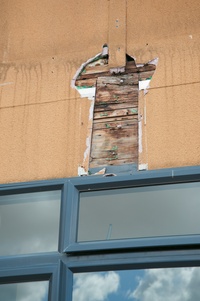
One challenge contractors had to face was dealing with 153 individual clients. Each owner – and tenant – had different needs and expectations and all wanted to know what was happening with their respective units. Some owners took the opportunity while work was going on to renovate and refurbish their units and while Canam’s original scope of work was limited to works associated with the remediation and recladding, inevitably some owners wanted more.
With so many clients and contractors on site, overseeing the relationship between the individual unit owners and contractors needed significant input and careful management – and here CoveKinloch and clerk of works Kevin Ahern played an important role. “Kevin was the linchpin between the owner/occupiers and the contractors and he helped make sure things went smoothly and according to plan,” says Leishman.
Canam have learned some valuable skills and lessons from this project, which they are already putting to good use. “We have developed a real depth of knowledge and expertise in the remediation process across our whole team. We have been able to gain specific knowledge and skills, and develop our own Canam systems and procedures among our carpenters, site managers, quantity surveyors and project management and planning personnel,” says Page. “Half of the team that was on this job have already moved on to another remediation job in Grafton. So it’s enabled us to secure more work already and we’ve got other significant opportunities in the pipeline.”
So, after 11 long years the owners and residents can begin to move on. Indeed, the body corporate is already taking steps to shake off the past by renaming the complex Botany Palms and is planning a rebranding and relaunch in November. And judging by the for sale signs that have sprung up since completion, things are looking up, with apartments apparently selling well.
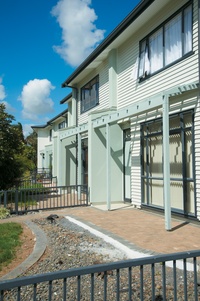
“The owners are happy they have a finished, marketable product,” says Papworth. “People can buy now with confidence. They seem to be selling well so that’s a good testimony to the finished product.” Martyn Cleary agrees. “Feedback received from the owners indicates they are delighted with the finish and look of the refurbished premises.”
The original goal of recladding and restoring financial value in the 153 units in the Sacramento complex has been achieved, but sadly for many other homeowners the misery and anxiety of leaky building syndrome continues. “Unfortunately I think leaky building refurbishment is an area that over the next several years is going to be a significant part of the workload in and around Auckland,” says Page. “I suspect we have only scratched the surface of this sort of work as an industry.”
Follow Progressive Building on Twitter: @ProBuildingNZ

